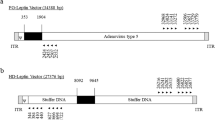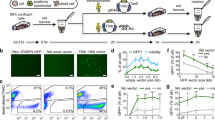Abstract
The ideal gene therapy vector should enable persistent expression without the limitations of safety and reproducibility. We previously reported that a prototype plasmid vector, containing a scaffold matrix attachment region (S/MAR) domain and the luciferase reporter gene, showed transgene expression for at least 6 months following a single administration to MF1 mice. Following partial hepatectomy of the animals, however, we found no detectable vector replication and subsequent propagation in vivo. To overcome this drawback, we have now developed an in vivo liver selection strategy by which liver cells transfected with an S/MAR plasmid are provided with a survival advantage over non-transfected cells. This allows an enrichment of vectors that are capable of replicating and establishing themselves as extra-chromosomal entities in the liver. Accordingly, a novel S/MAR plasmid encoding the Bcl-2 gene was constructed; Bcl-2 expression confers resistance against apoptosis-mediated challenges by the Fas-activating antibody Jo2. Following hydrodynamic delivery to the livers of mice and frequent Jo2 administrations, we demonstrate that this Bcl-luciferase S/MAR plasmid is indeed capable of providing sustained luciferase reporter gene expression for over 3 months and that this plasmid replicates as an episomal entity in vivo. These results provide proof-of-principle that S/MAR vectors are capable of preventing transgene silencing, are resistant to integration and are able to confer mitotic stability in vivo when provided with a selective advantage.
This is a preview of subscription content, access via your institution
Access options
Subscribe to this journal
Receive 12 print issues and online access
$259.00 per year
only $21.58 per issue
Buy this article
- Purchase on Springer Link
- Instant access to full article PDF
Prices may be subject to local taxes which are calculated during checkout




Similar content being viewed by others
References
Wong SP, Argyros O, Coutelle C, Harbottle RP . Strategies for the episomal modification of cells. Curr Opin Mol Ther 2009; 11: 433–441.
Sclimenti CR, Neviaser AS, Baba EJ, Meuse L, Kay MA, Calos MP . Epstein-Barr virus vectors provide prolonged robust factor IX expression in mice. Biotechnol Prog 2003; 19: 144–151.
Strayer D, Branco F, Zern MA, Yam P, Calarota SA, Nichols CN et al. Durability of transgene expression and vector integration: recombinant SV40-derived gene therapy vectors. Mol Ther 2002; 6: 227–237.
Rickinson A . Epstein-Barr virus. Virus Res 2002; 82: 109–113.
Schulz TF, Cordes S . Is the Epstein-Barr virus EBNA-1 protein an oncogen? Proc Natl Acad Sci USA 2009; 106: 2091–2092.
Jackson DA, Juranek S, Lipps HJ . Designing nonviral vectors for efficient gene transfer and long-term gene expression. Mol Ther 2006; 14: 613–626.
Jenke AC, Scinteie MF, Stehle IM, Lipps HJ . Expression of a transgene encoded on a non-viral episomal vector is not subject to epigenetic silencing by cytosine methylation. Mol Biol Rep 2004; 31: 85–90.
Argyros O, Wong SP, Niceta M, Waddington SN, Howe SJ, Coutelle C et al. Persistent episomal transgene expression in liver following delivery of a scaffold/matrix attachment region containing non-viral vector. Gene Ther 2008; 15: 1593–1605.
Piechaczek C, Fetzer C, Baiker A, Bode J, Lipps HJ . A vector based on the SV40 origin of replication and chromosomal S/MARs replicates episomally in CHO cells. Nucleic Acids Res 1999; 27: 426–428.
Schaarschmidt D, Baltin J, Stehle IM, Lipps HJ, Knippers R . An episomal mammalian replicon: sequence-independent binding of the origin recognition complex. EMBO J 2004; 23: 191–201.
Papapetrou EP, Zoumbos NC, Athanassiadou A . Genetic modification of hematopoietic stem cells with nonviral systems: past progress and future prospects. Gene Ther 2005; 12 (Suppl 1): S118–S130.
Jenke BH, Fetzer CP, Stehle IM, Jonsson F, Fackelmayer FO, Conradt H et al. An episomally replicating vector binds to the nuclear matrix protein SAF-A in vivo. EMBO Rep 2002; 3: 49–54.
Manzini S, Vargiolu A, Stehle IM, Bacci ML, Cerrito MG, Giovannoni R et al. Genetically modified pigs produced with a nonviral episomal vector. Proc Natl Acad Sci USA 2006; 103: 17672–17677.
Guidotti JE, Mallet VO, Mitchell C, Fabre M, Schoevaert D, Opolon P et al. Selection of in vivo retrovirally transduced hepatocytes leads to efficient and predictable mouse liver repopulation. FASEB J 2001; 15: 1849–1851.
Lacronique V, Mignon A, Fabre M, Viollet B, Rouquet N, Molina T et al. Bcl-2 protects from lethal hepatic apoptosis induced by an anti-Fas antibody in mice. Nat Med 1996; 2: 80–86.
Ogasawara J, Watanabe-Fukunaga R, Adachi M, Matsuzawa A, Kasugai T, Kitamura Y et al. Lethal effect of the anti-Fas antibody in mice. Nature 1993; 364: 806–809.
Lewis DL, Wolff JA . Systemic siRNA delivery via hydrodynamic intravascular injection. Adv Drug Deliv Rev 2007; 59: 115–123.
Stehle IM, Postberg J, Rupprecht S, Cremer T, Jackson DA, Lipps HJ . Establishment and mitotic stability of an extra-chromosomal mammalian replicon. BMC Cell Biol 2007; 8: 33.
Rupprecht S, Lipps HJ . Cell cycle dependent histone dynamics of an episomal non-viral vector. Gene 2009; 439: 95–101.
Papapetrou EP, Ziros PG, Micheva ID, Zoumbos NC, Athanassiadou A . Gene transfer into human hematopoietic progenitor cells with an episomal vector carrying an S/MAR element. Gene Ther 2006; 13: 40–51.
Acknowledgements
We thank Prof. Hans Lipps (University of Witten, Germany) for kindly providing us with the S/MAR element and Dr Georgina Lang (Cancer Research UK) for providing us with the Bcl-2 gene. Dr Steven Howe performed the quantitative PCR. This work has been supported by the Myrovlytis Trust.
Author information
Authors and Affiliations
Corresponding author
Ethics declarations
Competing interests
The authors declare no conflict of interest.
Rights and permissions
About this article
Cite this article
Wong, S., Argyros, O., Coutelle, C. et al. Non-viral S/MAR vectors replicate episomally in vivo when provided with a selective advantage. Gene Ther 18, 82–87 (2011). https://doi.org/10.1038/gt.2010.116
Received:
Revised:
Accepted:
Published:
Issue Date:
DOI: https://doi.org/10.1038/gt.2010.116
Keywords
This article is cited by
-
Generation of a tumor- and tissue-specific episomal non-viral vector system
BMC Biotechnology (2013)
-
Genetic modification of dividing cells using episomally maintained S/MAR DNA vectors
Molecular Therapy - Nucleic Acids (2013)
-
Development of S/MAR minicircles for enhanced and persistent transgene expression in the mouse liver
Journal of Molecular Medicine (2011)



